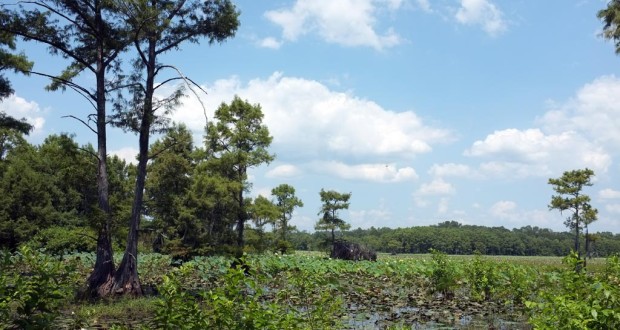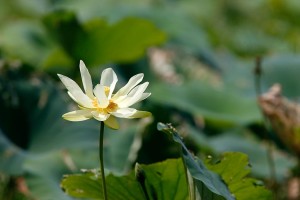Once part of the Longhorn Army Ammunition Plant, the land was turned over the the U.S. Fish and Wildlife Service more than a decade ago for development of the refuge. Buildings were demolished, utilities removed and trails blazed through the forest. Today the refuge is a remarkable work in progress.
Its curators have chosen to maintain many of the old roads and added fresh street signs at the corners, but look behind some of them and you’ll see the faded, rusted originals. A few old streetlights remain, no longer connected to the power grid. Weedy dirt lots look like a location for a new house rather than the buildings that were once there. At the end of one road a pair of houses is being overtaken by vines – and time.
Some of the refuge’s trails are blazed but don’t yet have a name attached to their trail heads. The park’s interpretive signs, a bird blind and other markers are trimmed in freshly cut wood. At the visitors center, a large artillery shell is a reminder of the refuge’s former self.
A six-mile-long auto tour travels the refuge’s streets through the forest, with trails that branch off here and there. The most interesting drive is along the red gravel Starr Ranch Road, which terminates at two abandoned houses and a boat ramp on Caddo Lake, though with the lake down significantly, it’s more of a mud ramp now. In summer, vast fields of yellow American Lotus stretch out on the lake into the distance.
The Starr Ranch Trail (2.5 miles) by the main house follows the edge of the lake into the forest, though views of the lake are sometimes limited by thick vegetation. The trail is rough, marked in places by red blazes, and it gets muddy during wet weather.
The short Magazine Trail (0.5 mile) winds along the bank of a forest creek, but is not as clearly marked as other trails and interrupted in places by fallen trees.
The long Wildlife Observation Trail (9 miles) begins near the refuge entrance and encircles the central area of the park, following an old railroad right of way for part of its distance. It’s more developed than the other trails and open to both hiking and horseback riding.
The wetlands around Caddo Lake are home to more than 200 bird, 45 mammal and 90 reptilian and amphibian species, including alligators and one of the largest breeding populations of wood ducks and prothonatary warblers.
Near the visitors center is a facility for raising salvinia weevils – small insects that feed on the invasive giant salvinia fern that is overwhelming parts of Caddo Lake. The operation raises the weevils en masse and then releases them into the lake to rein in the salvinia’s advance.
Overall, the Caddo Lake Refuge offers relatively undisturbed forest walks, a scenic glimpse of Caddo Lake and a look at a park in transition to its natural state. And it’s just down the road from the bayous of Caddo Lake State Park.


